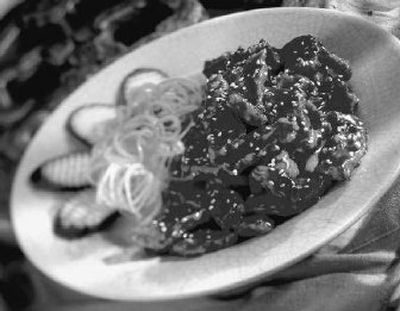Gather family for a Chinese New Year feast

Chinese New Year on Feb. 18 marks the perfect time to fire up a wok and gather the family for a celebratory feast ushering in the Year of the Pig.
In China, the New Year’s Eve dinner is so important that if a family member can’t attend, an empty seat is kept to symbolize their presence! Don’t panic if busy schedules make the planning difficult — Chinese New Year is celebrated for 15 days. Also, cooking with a wok is a quick way to make a delicious meal; the high temperatures sear in the juices of meats and conveniently cook food in minutes.
Two recipes to start your menu, along with instructions for a traditional “Tray of Togetherness,” are listed here, provided by the chefs at Panda Express. To round out the meal, consider chow mein or lo mein, because noodles signify long life. Green beans represent longevity and are a good choice of vegetable. Egg rolls or spring rolls are appropriate because they resemble the shape of a gold bar, so they’re often served as a symbol of wealth in the coming year.
For a great conversation starter, create place cards for each guest sharing their animal in the Chinese zodiac. Eating with chopsticks helps make the meal special. Red and gold, traditional symbols of luck and prosperity, can be used in the tablecloth, placemats and napkins to make the table look instantly festive. For a unique centerpiece, arrange fresh flowers in small cups and place them in Chinese food to-go cartons.
Tangerine Pork Tenders
2007 marks the Year of the Pig, so celebrating with pork chops is especially suitable. Tangerines symbolize wealth and prosperity in the Chinese culture, adding a delicious twist to holiday cooking.
Serves 4
Courtesy of Panda Express
15 ounce pork tenderloin
1 teaspoon cornstarch
3 tablespoons cooking oil
1/2 teaspoon minced garlic
1 teaspoon minced ginger
1 teaspoon minced scallion
1 tangerine, cut in half and sliced into 1/4 -inch pieces (squeeze 1/2 tablespoon of juice from one or two sections for Group A mixture; use the rest to garnish the plate)
Pinch of sesame seeds
Marinade
2 teaspoons salt
1 teaspoon cooking wine
1 1/2 tablespoons water
1 teaspoon minced ginger
1 teaspoon minced scallion
2 tablespoons cornstarch
1 egg white
1 tablespoon cooking oil
Group A
2 tablespoons ketchup
1/4 teaspoon Worcestershire sauce
1 teaspoon soy sauce
1 1/2 teaspoons cornstarch
1 tablespoon sesame oil
2 tablespoons sugar
2 tablespoons vinegar
2 tablespoons water
1/2 tablespoon tangerine juice
Combine all marinade ingredients. Slice pork into 2- by-1 1/2 - by 1/4 -inch strips and add to marinade. Refrigerate for two hours.
Dust pork with cornstarch. Heat 2 tablespoons oil in wok until hot. Cook pork slices in single layer batches until cooked. Set aside.
Combine Group A ingredients in a bowl; set aside.
Stir-fry garlic, ginger and scallion in 1 teaspoon cooking oil. Add Group A to the wok and cook until sauce thickens. Add pork slices and toss to coat.
Sprinkle on sesame seeds, and garnish the plate with tangerine slices or as desired.
Sweet Sesame Balls
On special occasions or holidays, the Chinese serve sweets as a way to wish good fortune. Starting a new year with some sweetness is certainly a good way to mark a new beginning.
Serves 5 (2 sesame balls each)
Courtesy of Panda Express
1/4 cup all-purpose flour
1/4 cup water
1/2 cup sweet lotus paste (available at Asian grocery stores; red bean paste can be substituted if sweet lotus paste cannot be found)
1/2 cup sesame seeds
7 cups cooking oil
Powdered sugar
Mint leaves
Group A
1 cup sweet rice flour (available at Asian grocery stores)
1/3 cup cold water
2 tablespoons sugar
1/4 tablespoon baking powder
Pour flour in mixing bowl. Boil water and mix with flour. Add Group A ingredients to the bowl and mix together.
Form 10 balls out of the mixture and pound flat.
Place 2 teaspoons of sweet lotus paste in each flattened ball; roll into a ball shape again.
Roll balls in sesame seeds.
Heat oil to medium-low heat in wok and place balls inside. Deep fry for about four minutes, or until outside is golden brown and balls float on top of oil.
Remove balls and set on plate. Garnish with powdered sugar and serve with mint.
Tray of Togetherness
Eight is considered the luckiest number in the Chinese culture, bringing good fortune and happiness. A traditional “Tray of Togetherness” featuring eight special treats, including candy, dried fruit and nuts, is often shared at Chinese New Year. In the example photographed here, clockwise from top center are:
1. Sesame sticks, said to bring many children
2. Red melon seeds, because the color red symbolizes happiness and joy
3. Candied winter melon, representing growth and good health
4. Kumquats, because the color gold means prosperity
5. Peanuts, signifying longevity
6. Lucky money candy, leading to a sweet and prosperous year
7. Lotus seeds, attributed to fertility
8. Longans (an Asian fruit), said to bring many good sons